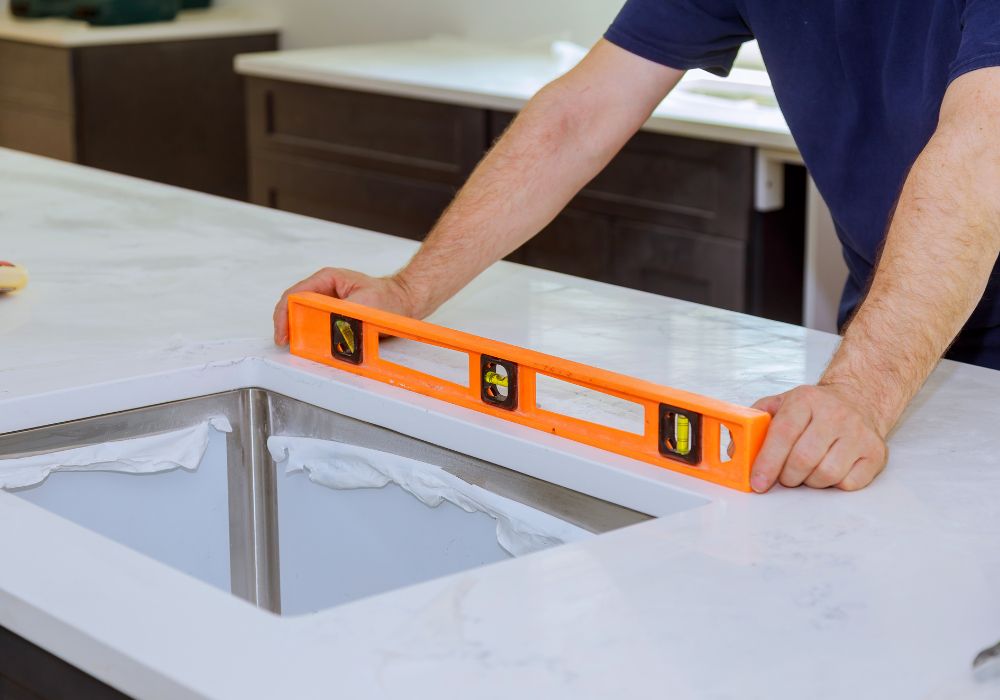Installing a countertop is a significant investment for any homeowner, and as a contractor, determining how much to charge can be complex. This guide will help you understand the various factors that influence countertop installation costs, provide insights into setting your prices, and ensure you offer fair and competitive rates.
Understanding the Basics of Countertop Installation Costs
Factors Influencing Installation Costs
Countertop installation costs are not one-size-fits-all. Several factors can significantly impact the final price, including:
- Material: Different materials come with varying costs. Granite, marble, quartz, and laminate all have different price points.
- Project Complexity: The design and layout of the kitchen, including the number of cutouts and edges, can affect the labor required.
- Geographical Location: Prices can vary based on the cost of living and demand for services in your area.
Lee Wallace, CEO of Stone Fabricators Alliance, emphasizes:
“Countertop installation costs are not one-size-fits-all. Factors like material, complexity of the project, and geographical location can significantly impact the final price.” – Lee Wallace (Source: Stone World Magazine)
Average Costs for Different Materials
Here’s a quick overview of average costs for various countertop materials per square foot, including installation:
- Laminate: $20 – $50
- Butcher Block: $50 – $100
- Granite: $40 – $100
- Quartz: $50 – $150
- Marble: $75 – $200
Additional Costs
- Demolition: Removing old countertops can add to the overall cost.
- Plumbing and Electrical: Any necessary plumbing or electrical adjustments.
- Sealing and Finishing: Certain materials like granite and marble may require sealing.
Setting Your Pricing
Calculating Your Costs
To determine your pricing, start by calculating all costs involved in the project. This includes:
- Materials: Cost of the countertop material itself.
- Labor: Your time and the time of any crew members.
- Overhead: Transportation, tools, insurance, and other business expenses.
Fred Hueston, a Certified Kitchen Designer, advises:
“Don’t undercharge for your expertise and craftsmanship. Factor in your overhead costs, labor, and the value you bring to the project when determining your pricing.” – Fred Hueston (Source: NKBA)
Transparency with Clients
Transparency is key to building trust with your clients. Provide a detailed breakdown of the costs involved, including materials, labor, and any additional fees. Dan DiClerico, a home improvement expert, suggests:
“Transparency is key when it comes to pricing. Provide your clients with a detailed breakdown of the costs involved, including materials, labor, and any additional fees, to avoid misunderstandings and ensure a smooth transaction.” – Dan DiClerico (Source: Consumer Reports)
Offering Pricing Tiers
Consider offering different pricing tiers for different levels of service. This allows you to cater to a wider range of clients and budgets. Sarah Barnard, a design director, recommends:
“Consider offering different pricing tiers for different levels of service. This allows you to cater to a wider range of clients and budgets.” – Sarah Barnard (Source: Sarah Barnard Design)
Providing Written Contracts
Always provide a written contract that clearly outlines the scope of work, payment terms, and any warranties or guarantees. Kerrie Kelly, an interior designer, emphasizes:
“Always provide a written contract that clearly outlines the scope of work, payment terms, and any warranties or guarantees. This protects both you and the client and ensures a successful project.” – Kerrie Kelly (Source: Kerrie Kelly Design Lab)
Personal Anecdotes: Lessons Learned in Pricing
The First Big Job
When I landed my first major countertop installation job, I underpriced my services, thinking it would attract more clients. While I got the job, I barely made a profit. That experience taught me the importance of valuing my work and factoring in all costs, including overhead and labor.
The Importance of Transparency
I once had a client who was shocked by the final bill because I hadn’t provided a detailed estimate upfront. After that, I started giving comprehensive breakdowns of all costs involved, which led to smoother transactions and happier clients.
Market Insights and Trends
Kitchen Trends and Costs
According to the “2023 Houzz & Home Study: Kitchen Trends,” the average cost of a major kitchen remodel in the United States, including countertop installation, was $45,000. However, costs can vary significantly depending on the size of the kitchen, the type of countertops chosen, and the complexity of the project.
Cost vs. Value
The “Cost vs. Value Report” by Remodeling Magazine provides a comprehensive analysis of the average cost of various home improvement projects, including countertop replacement, and the expected return on investment for each project. This information can be helpful for contractors and homeowners in determining the potential value of investing in new countertops.
Unique Insights and Tips
Understanding Client Needs
Each client has unique needs and preferences. Some may prioritize cost, while others may focus on quality or aesthetic appeal. Understanding these priorities can help you tailor your services and pricing accordingly.
Staying Competitive
To stay competitive, keep an eye on market rates in your area and adjust your pricing as needed. Offering exceptional customer service and high-quality workmanship can also justify higher rates.
Continuous Learning
Stay updated with the latest trends and technologies in countertop materials and installation techniques. This not only enhances your skills but also allows you to offer the best solutions to your clients.
Conclusion: Charging Fairly and Competitively
Determining how much to charge for countertop installation involves considering various factors, including material costs, labor, overhead, and market trends. By being transparent with clients, offering different pricing tiers, and providing detailed contracts, you can build trust and ensure a successful project.

